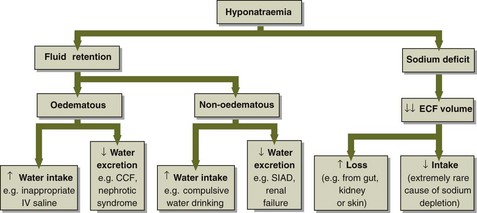8 The causes of hyponatraemia due to water retention are shown in Figure 8.1. Water retention usually results from impaired water excretion and rarely from increased intake (compulsive water drinking). Most patients who are hyponatraemic due to water retention have the so-called syndrome of inappropriate antidiuresis (SIAD). The SIAD is encountered in many conditions, e.g. infection, malignancy, chest disease, and trauma (including surgery); it can also be drug-induced. SIAD results from the inappropriate secretion of AVP. Whereas in health the AVP concentration fluctuates between 0 and 5 pmol/L due to changes in osmolality, in SIAD huge (non-osmotic) increases (up to 500 pmol/L) can be seen. Powerful non-osmotic stimuli include hypovolaemia and/or hypotension, nausea and vomiting, hypoglycaemia, and pain. The frequency with which SIAD occurs in clinical practice mirrors the widespread prevalence of these stimuli. It should be stressed that the increase in AVP secretion induced by, say, hypovolaemia is an entirely appropriate mechanism to try to restore blood volume to normal. The term ‘inappropriate’ in SIAD is used specifically to indicate that the secretion of AVP is inappropriate for the serum osmolality. AVP has other effects in the body aside from regulating renal water handling (Table 8.1).
Hyponatraemia
pathophysiology
Development of hyponatraemia
 Loss of sodium. Sodium is the main extracellular cation and plays a critical role in the maintenance of blood volume and pressure, by osmotically regulating the passive movement of water. Thus when significant sodium depletion occurs, water is lost with it, giving rise to the characteristic clinical signs associated with ECF compartment depletion. Primary sodium depletion should always be actively considered if only to be excluded; failure to do so can have fatal consequences.
Loss of sodium. Sodium is the main extracellular cation and plays a critical role in the maintenance of blood volume and pressure, by osmotically regulating the passive movement of water. Thus when significant sodium depletion occurs, water is lost with it, giving rise to the characteristic clinical signs associated with ECF compartment depletion. Primary sodium depletion should always be actively considered if only to be excluded; failure to do so can have fatal consequences.
 Water retention. Retention of water in the body compartments dilutes the constituents of the extracellular space including sodium, causing hyponatraemia. Water retention occurs much more frequently than sodium loss, and where there is no evidence of fluid loss from history or examination, water retention as the mechanism becomes a near-certainty.
Water retention. Retention of water in the body compartments dilutes the constituents of the extracellular space including sodium, causing hyponatraemia. Water retention occurs much more frequently than sodium loss, and where there is no evidence of fluid loss from history or examination, water retention as the mechanism becomes a near-certainty.
Water retention
Hyponatraemia: pathophysiology





